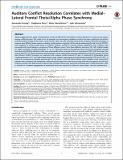Auditory Conflict Resolution Correlates with Medial–Lateral Frontal Theta/Alpha Phase Synchrony
Author(s)
Huang, Samantha; Rossi, Stephanie; Ahveninen, Jyrki; Hamalainen, Matti S.
DownloadHuang-2014-Auditory Conflict Re.pdf (4.738Mb)
PUBLISHER_CC
Publisher with Creative Commons License
Creative Commons Attribution
Terms of use
Metadata
Show full item recordAbstract
When multiple persons speak simultaneously, it may be difficult for the listener to direct attention to correct sound objects among conflicting ones. This could occur, for example, in an emergency situation in which one hears conflicting instructions and the loudest, instead of the wisest, voice prevails. Here, we used cortically-constrained oscillatory MEG/EEG estimates to examine how different brain regions, including caudal anterior cingulate (cACC) and dorsolateral prefrontal cortices (DLPFC), work together to resolve these kinds of auditory conflicts. During an auditory flanker interference task, subjects were presented with sound patterns consisting of three different voices, from three different directions (45° left, straight ahead, 45° right), sounding out either the letters “A” or “O”. They were asked to discriminate which sound was presented centrally and ignore the flanking distracters that were phonetically either congruent (50%) or incongruent (50%) with the target. Our cortical MEG/EEG oscillatory estimates demonstrated a direct relationship between performance and brain activity, showing that efficient conflict resolution, as measured with reduced conflict-induced RT lags, is predicted by theta/alpha phase coupling between cACC and right lateral frontal cortex regions intersecting the right frontal eye fields (FEF) and DLPFC, as well as by increased pre-stimulus gamma (60–110 Hz) power in the left inferior fontal cortex. Notably, cACC connectivity patterns that correlated with behavioral conflict-resolution measures were found during both the pre-stimulus and the pre-response periods. Our data provide evidence that, instead of being only transiently activated upon conflict detection, cACC is involved in sustained engagement of attentional resources required for effective sound object selection performance.
Date issued
2014-10Department
Harvard University--MIT Division of Health Sciences and Technology; McGovern Institute for Brain Research at MITJournal
PLoS ONE
Publisher
Public Library of Science
Citation
Huang, Samantha, Stephanie Rossi, Matti Hämäläinen, and Jyrki Ahveninen. “Auditory Conflict Resolution Correlates with Medial–Lateral Frontal Theta/Alpha Phase Synchrony.” Edited by Lawrence M. Ward. PLoS ONE 9, no. 10 (October 24, 2014): e110989.
Version: Final published version
ISSN
1932-6203